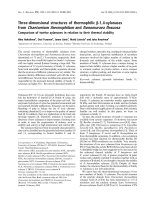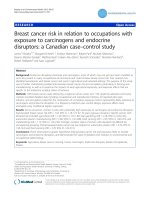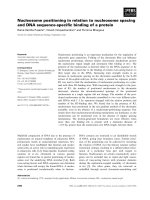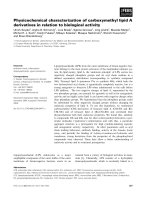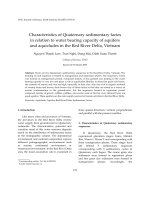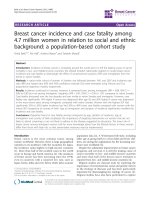Tuberculosis in cancer patients: Role of newer techniques in relation to conventional diagnostic methods
Bạn đang xem bản rút gọn của tài liệu. Xem và tải ngay bản đầy đủ của tài liệu tại đây (235.72 KB, 6 trang )
Journal of Advanced Research (2010) 1, 157–162
Cairo University
Journal of Advanced Research
ORIGINAL ARTICLE
Tuberculosis in cancer patients: Role of newer techniques
in relation to conventional diagnostic methods
Hadir A. El-Mahallawy a,∗, Somia A. Eissa b, Nefissa G. Rafeh a, Ayman E.S. Salem c,
Soheir A. Eissa a , Soheir A. Allian b
a
Department of Clinical Pathology, National Cancer Institute, Cairo University, Kasr El-Aini Street, Kornish El-Nil, Fom El-Khalig,
11796, Cairo, Egypt
b
Department of Microbiology and Immunology, Faculty of Medicine, Cairo University, Egypt
c
Chest Department, Faculty of Medicine, Cairo University, Egypt
Available online 6 March 2010
KEYWORDS
Tuberculosis;
Mycobacterium
tuberculosis direct test
(MTD);
Mycobacteria growth
indicator tube (MGIT);
TB infections;
Cancer patients
Abstract The highly infectious nature of tuberculosis (TB) urges the need to increase the efficiency
and rapidity of lab methods. The coexistence of TB and cancer was investigated using Mycobacterium
tuberculosis direct test (MTD) and the mycobacteria growth indicator tube (MGIT), besides the conventional
lab procedures. All assays were performed on 101 patients clinically suspected of having a mycobacterial
infection. Over a period of 4 years, TB was confirmed in 32 patients with malignancy by applying the gold
standard of considering patients with positive culture on Lowenstein–Jensen or MGIT or having any two
or more positive tests as confirmed mycobacterial infection. Among the confirmed cases, the underlying
malignant conditions were hematologic malignancies, bronchogenic carcinoma, and other solid tumors, in
14, 12, and 6 of the patients; respectively. TB developed during cancer chemotherapy in 18 cases (56%),
and was discovered synchronously with malignancy in 14 (44%) patients. The ZN stain revealed acid-fast
bacilli in 15 (47%) cases. The LJ culture was positive in 20 (63%) cases and MGIT was positive in 18 (56%)
cases. Although the MTD test was positive in 18 (56%) of the confirmed TB cases; i.e., it was negative in
14 cases positive by other tests. There was a moderate agreement between results of LJ and MGIT, Kappa
0.396 and ZN and MGIT, Kappa 0.436. There was a weak agreement between results of LJ and MTD, ZN
and MTD, Kappa 0.227 and 0.209; respectively; whereas, no agreement was calculated between MGIT
and MTD Kappa 0.029. The calculation of the combined sensitivity of any two tests was 94%. TB is a
major pathogen in patients with malignant diseases if clinically suspected. Little overlap between different
technologies used necessitates the utilization of combination of tests together with consideration of key
clinical characteristics to improve the diagnostic accuracy of TB.
© 2010 Cairo University. All rights reserved.
Introduction
∗
Corresponding author. Tel.: +20 12 3430821; fax: +20 23 644720.
E-mail address: (H.A. El-Mahallawy).
2090-1232 © 2010 Cairo University. Production and hosting by Elsevier. All
rights reserved. Peer review under responsibility of Cairo University.
Production and hosting by Elsevier
doi:10.1016/j.jare.2010.03.008
Tuberculosis is still a leading health problem as reported by the
World Health Organization (WHO), with an estimated 8 million
new cases annually. In Egypt, TB prevalence has been estimated to
be 35 cases/100,000 in the year 2004 [1].
The relationship between TB and cancer is of dual nature.
Patients with malignant diseases are at increased risk for diseases caused by mycobacteria. Patients with depressed cellular
immunity such as those who have lymphoproliferative disorders,
158
transplant patients and patients on immunosuppressive therapy
are at particular risk [2]. Alternatively, TB may occasionally be
misinterpreted as cancer [3]. Furthermore, delay in TB diagnosis
in patients with leukemia and active TB results in transmission of Mycobacterium tuberculosis to other immunosuppressed
patients [4]. Therefore, baseline TB screening and earlier clinical
recognition of active disease could reduce healthcare facilityassociated transmission of MTB among patients with malignant
diseases.
Conventional laboratory procedures for MTB detection rely
upon microscopic examination for the presence of acid-fast bacilli
(AFB), and culture on solid and/or liquid media. Microscopic examination for AFB is rapid but has a very limited sensitivity. Although
culture is still the gold standard for diagnosis of TB, it may require
a turnaround time of 2–8 weeks [5]. Therefore, Novel TB diagnostics have been introduced to aid in earlier and more sensitive
identification of cases.
The mycobacteria growth indicator tube, a non-radioactive broth
based culture system is a rapid detection method for isolation of
mycobacteria from clinical specimens [6]. The M. tuberculosis
direct test is an isothermal transcription-mediated amplification system in which specific mycobacterial 16S rRNA target is amplified
using DNA intermediaries. In 1999, the Food and Drug Administration approved it for the diagnosis of MTB in smear-positive and
-negative specimens from patients suspected of having TB [7]. Little literature showing side by side field performance of these tests in
susceptible cancer patients is available. The aim of the present study
was primarily to assess the demographics of TB infection in patients
with malignant diseases and secondly to evaluate the role of newer
techniques in the diagnosis of TB in comparison to conventional
laboratory procedures.
Patient and methods
This was a prospective study performed at the National Cancer
Institute (NCI), Cairo University, a university based tertiary care
center receiving an excess of 15,000 newly diagnosed cases of cancer each year. The study was approved by the Ethics Committee
of the NCI and an informed written consent was obtained from all
participants.
Study design
Patients were included in the study if they had clinical symptoms
and/or radiological evidence suggestive of TB. Cancer patients were
referred by clinicians to microbiology lab from surgical, medical
and pediatric oncology departments at National Cancer Institute,
Cairo University when clinically suspected of having TB infection. Inclusion criteria were chronic cough for more than 2 weeks,
recurrent chest infection, dyspnea, hemoptysis, and weight loss.
All four tests were done for all enrolled cases. A diagnosis of
TB was confirmed by applying the gold standard of considering
patients with positive culture and those having two or more tests
positive. Response to therapy was not considered in the present
study.
Conventional laboratory procedures
Specimens were collected according to the suspected site of disease.
Sputum samples were obtained on 3 successive days. Bronchoalveolar lavage (BAL) fluid was collected during bronchoscopy. Other
H.A. El-Mahallawy et al.
samples included pus, tissue biopsy, and sterile body site fluids.
Samples were subjected to direct Ziehl Neelsen (ZN) staining, followed by decontamination. Tissues were grinded, mixed with sterile
saline before processing. Specimens were digested and decontaminated by the N-acetyl-l-cysteine NaOH method. ZN stain was
done again after decontamination. Cultivation of the specimens was
carried out on Lowenstein–Jensen (LJ) screw capped bottles and
kept for 8 weeks [8]. Any growth detected was confirmed by ZN
stain.
Mycobacteria growth indicator tube (MGIT)
Tubes were supplied by Becton Dickinson Microbiology Systems,
US. Specimen inoculation was carried out as recommended by the
manufacturer [6]. The MGIT contains 4.0 ml of 7H9 broth with
0.25% glycerol. The bottom of this tube has a fluorescent indicator embedded in silicone. Consumption of oxygen by the growing
mycobacteria activates the indicator, which produces fluorescence
(bright orange colors on the bottom and the meniscus) when the
tube is exposed to UV light generated by a 365-nm UV transilluminator. Before inoculation with the processed specimens, the tubes
have to be supplemented with 0.5 ml of OADC (oleic acid, albumin
[bovine], dextrose, catalase) and antibiotics. Tubes were read utilizing a UV lamp next to positive and negative controls. Negative
tubes were read weekly for up to 4 weeks. Contamination was suspected if fluorescence occurred within 24–72 h after inoculating the
tubes.
Molecular diagnosis
Amplified M. tuberculosis direct test (MTD) was purchased from
Gen-Probe, US. Digested decontaminated samples were stored
at −20 ◦ C until the amplification technique was performed. The
amplification assays were run in three separate areas which have
been set up specifically for MTD. The MTD test is an isothermal
transcription-mediated amplification system based on the reverse
transcription of mycobacterial-specific rRNA targets, followed by
transcription of the DNA intermediate template. Subsequent detection of RNA amplicons is through a hybridization protection assay
using an acridinium ester-labeled M. tuberculosis complex-specific
DNA probe. The MTD test was performed according to the manufacturer instructions [9]. Each run included a positive control prepared
from a suspension of MTB, and a negative control prepared from a
suspension of MOTT. A cutoff value of 30,000RLU was used for
positive specimens [10].
Statistical methods
Standard descriptive statistical methods were used to describe
the patient population. Numeric data were summarized as
mean ± standard deviation, categorical measurements and percentages. Comparison between two groups for numeric variables was
done using Mann–Whitney test, and Kruskal–Wallis test for more
than two groups. Comparison between categorical measurements
was done using the Chi-square or Fisher exact tests, depending
on sample size. The results of TB diagnostic tests were studied
for their strength of agreement using the Kappa coefficient. Data
were analyzed using Statistical Analysis Systems SPSS in statistical package version 12. All p-values were 2 sided. p-values < 0.05
were considered significant.
Diagnosis of tuberculosis in cancer patients
159
Table 1 The clinical characteristics, and type of sample of 101
cancer patients clinically suspected of having mycobacterial infection included in the study.
Table 2 The relation between the results of different tests done
on 101 patients with malignant diseases and clinically suspected to
be tuberculous.
Parameter
Number (%)
No. of tests positive
Sex
Male
Female
ZN
15
LJ
20
MGIT
18
MTD
30
62 (61.4)
39 (38.6)
Four tests
+
+
+
+
2
Three tests
+
+
+
+
+
+
+
+
1
2
2
(years)a
Age
44.2 ± 20.4
(2–82)
Two tests
Diagnosis
Bronchogenic cancer, n = 43
Hematologic malignancy, n = 37
ALL
AML
CML
Lymphoma
11 (10.9)
4 (4.0)
2 (2.0)
20 (20.0)
Solid tumors, n = 21
21 (20.8)
Sample
Ascitic fluid
BAL
CSF
Pleural effusion
Pus
Sputum
Tissue
a
43 (42.6)
2 (2.0)
33 (32.7)
1 (1.0)
1 (1.0)
6 (5.9)
55 (54.5)
3 (3.0)
Values are means ± standard deviations.
Results
This study was carried out on 101 patients in different stages of
malignant diseases clinically suspected of having a mycobacterial
infection during the period from January 2001 to December 2004. Of
the 101 patients, 86 were adults and 15 were children below 18 years.
The bronchogenic carcinoma patients were studied as new cases for
the possibility of TB mimicking a malignant disease, whereas the
other cases were receiving therapy. The clinical characteristics of
101 patients are summarized in Table 1.
Mycobacterial studies
The ZN stain revealed acid-fast bacilli in 15 cases. The LJ culture
was positive in 20 cases. Growth was detected within 10–45 days.
The MGIT tubes were positive in 18 cases. Growth was detected
within 7–13 days. Bacteria or fungi were a source of contamination
in 17/101 samples.
The MTD test was positive in 30 cases, yet it was negative in 14 other cases that were deemed positive by the other
tests. Twelve cases (5 solid, 4 bronchogenic and 3 hematologic)
were only MTD positive, with all other tests negative. Clinically,
these patients had mild chronic symptoms and were stable without anti-tuberculous treatment. All tests were negative in 57 of
the cases (56%). The relation between the results of different tests
is shown in Table 2. Sensitivity, specificity, positive and negative
predictive values of the different tests are summarized in Table 3.
Tables 4 and 5 illustrate the strength of agreement between different
tests.
+
+
+
+
+
+
+
+
+
+
+
One test
+
+
+
1
3
4
6
6
3
1
1
+
One test
No. of cases
+
12
ZN + LJ were positive in 7 samples, ZN + MGIT were positive in 8 samples, ZN + MTD were positive in 9 samples, MGIT + LJ were positive in
10 samples, MGIT + MTD were positive in 6 samples, MTD + LJ were
positive in 10 samples. All tests were negative in 57 of the cases (56%).
Confirmed cases
By applying the golden rule, 32 cases were considered truly having mycobacterial infection. This constituted TB attack rate of
0.5/1000 new cancer case a year. Pulmonary TB was the most
common site of infection (28/32, 88%). Four cases manifested extrapulmonary mycobacterial infection, which were meningitis, psoas
abscess, chest wall abscess and laryngeal wound discharge. Among
the confirmed positive cases, hematologic malignancies were the
underlying disease in 14 patients (5 acute lymphoblastic leukemia,
8 lymphoma, and 1 acute myeloblastic leukemia), bronchogenic carcinoma in 12, and in 6 of other solid tumors. The difference between
the three groups was not statistically significant, p = 0.599. Of the 32
confirmed cases, 26 were adults and 6 were children. TB developed
during cancer chemotherapy in 56% (n = 18) of cases. TB was discovered synchronously with malignancy in 44% (n = 14) of patients.
The hematological malignancy patients were in a disease remission.
Table 3 summarizes the overall sensitivity, specificity, positive and
negative predictive values of the different tests in confirmed cases.
The combined sensitivity of any two tests was 94%.
Past history of TB
Sixteen patients (16%) had a past history of tuberculosis and had
previously received anti-tuberculous treatment (2–10 years before).
Of these cases, 9 had bronchogenic carcinoma (56%), 5 had hematologic malignancies (31%), and 2 cases of solid tumors (13%). Six of
these patients were confirmed TB positive, while 10 were negative
for TB. The relation between past history of TB, and recurrence of
TB with present malignant condition was not statistically significant,
p = 0.457.
Discussion
Diagnosis of TB can be clinically challenging. M. tuberculosis complex is highly infectious; therefore its diagnosis as early as possible
160
H.A. El-Mahallawy et al.
Table 3 Overall sensitivity, specificity, positive predictive and negative predictive values of the four tests for the confirmed TB cases by
applying the golden rule.
Measurement
Sensitivity (%)
(95% CI)
Specificity (%)
(95% CI)
Positive predictive value
(%) (95% CI)
Negative predictive
value (%) (95% CI)
ZN
LJ
MGIT
MTD
47 (30–65)
63 (44–78)
56 (38–73)
56 (38–73)
100 (93–100)
100 (93–100)
100 (93–100)
83 (71–90)
100 (75–100)
100 (80–100)
100 (79–100)
60 (41–77)
80 (70–88)
85 (75–92)
84 (74–91)
80 (68–88)
Table 4
The agreement between MGIT compared to both conventional procedures.
Agreement between tests
Negative
Negative
Positive
Positive
Negative
Positive
Negative
Positive
LJ and MGIT number (%)
ZN and MGIT number (%)
73 (72.2)
8 (7.9)
10 (9.9)
10 (9.9)
76 (75.3)
10 (9.9)
7 (6.9)
8 (7.9)
Kappa, measure of agreement. Kappa of LJ and MGIT was 0.396 (moderate agreement) and of ZN and MGIT was 0.436 (moderate agreement).
is of paramount importance. In the present study, detection of MTB
was attempted in patients with malignant diseases suspected clinically and/or radiologically of being tuberculous. During 4 years,
101 patients were evaluated for the possible coexistence of cancer
and TB. Of the 101 cases clinically suspicious for the possibility
of TB, 32 were confirmed positive by applying the golden standard for TB diagnosis. The most remarkable finding of the present
study is the lack of strong agreement between results of different
tests performed. There was a moderate agreement between MGIT
and conventional tests, and weak agreement between MTD and the
other three tests.
Considering the results of the four tests together, the expected
scenario of three or four tests positive in confirmed cases was quite
uncommon. Discrepancy between smear positivity and MTD with
culture was 7 in 20 and 10 in 20; respectively. Similarly, Tueller
et al. [11] reported that only 39% of culture positive pulmonary
TB had a positive sputum smear. Smear examination for acid-fast
bacilli demonstrated a specificity of 100% in the present study; still
its value is limited by its low sensitivity. Although ZN has a high predictive value, a negative AFB smear does not exclude TB, especially
if clinical suspicion is high. Culture of MTB is the gold standard for
diagnosis of TB. It is a much more sensitive test than smear examination and has been estimated to detect 10–100 viable mycobacteria
per ml of sample and in case of active disease they are found to be
81% sensitive and 98.5% specific [12]. A moderate agreement was
recorded between LJ and MGIT in the present study. The LJ culture
was positive in 20 cases with growth detected within 10–45 days,
whereas; MGIT tubes were positive in 18 cases detected within
7–13 days. So, it is evident that MGIT has the advantage of early
Table 5
detection. In conclusion, it was found that MGIT represents a valuable tool in laboratory protocol in conjunction with solid media for
obtaining rapid detection of growth from culture positive specimens
and for better overall sensitivity [13].
In the present study, MTD was positive in 18 of the 32 confirmed cases, and was negative in the remaining 14. This high false
negative rate for MTD in the current study in comparison with conventional methods does not justify its use as a single test for the
diagnosis of TB. Similarly, false negative results were previously
reported for MTD in comparison with culture [10]. Moreover, it is
agreed nowadays that the reliability of amplification methods for
the direct detection of MTB is not as satisfactory as for other microorganisms due to low sensitivity compared with culture and inability
to differentiate dead bacilli from the living [14]. Given the public
health concerns and very high morbidity and mortality of TB, the key
aspect of MTD performance is the negative predictive value; i.e., it
is critically important that any patient with TB not to be overlooked
[10].
Earlier studies had shown high sensitivity and specificity of the
MTD test, but that was recorded in smear-positive cases [15]. An
alternative explanation could be related to the fact that MTD specifically detects MTB but not MOTT. A recent study investigated the
use of gene probe in culture positive samples and was able to identify MTB in 77% of samples, while 23% were identified as MOTT
[16]. The MTD assay had a sensitivity of 100 and 75% for acid-fast
smear-positive and -negative respiratory specimens, respectively
[10]. In the latter study, reduced sensitivity was seen among acid-fast
smear-negative non-respiratory specimens (63.9%) when compared
to smear-positive specimens (90%).
The agreement between MTD compared to other TB tests performed in the study.
Agreement between tests
LJ and MTD number (%)
ZN and MTD number (%)
MGIT and MTD number (%)
Negative
Negative
Positive
Positive
62 (61.4)
19 (18.8)
10 (9.9)
10 (9.9)
65 (64.4)
21 (20.8)
6 (5.9)
9 (8.9)
59 (58.4)
13 (12.9)
23 (22.8)
6 (5.9)
Negative
Positive
Negative
Positive
Kappa values were 0.227 (weak agreement), 0.209 (weak agreement) and 0.029 (no agreement) between LJ and MTD, ZN and MTD, and MGIT and MTD;
respectively.
Diagnosis of tuberculosis in cancer patients
In the present study, 12 patients were MTD positive, with other
tests negative. Clinically, these patients had mild chronic symptoms
and were stable without anti-TB treatment. The possibility exists that
these patients were having a subclinical infection. The low specificity and positive predictive value observed in the present study
would markedly improve if those cases were considered subclinical
cases and excluded out of calculations. In general, the results of the
present study were similar to those of a previous study, reporting
11 discrepant results between cultures and MTD; five false positive
and six false negative results [10].
It is evident from the findings of the current study that TB diagnostic tests do not line up perfectly. Thus, the clinician is left with a
judgment call despite the introduction of new technology. One of the
most important criteria for establishing a presumptive diagnosis of
TB is a case definition, which may be based on clinical symptoms,
radiographic signs, risk factors, or a combination of these [15]. Similarly, a recent study concluded that a high index of suspicion for
TB and blood culture for MTB provide a simple and non-invasive
diagnostic method to detect disseminated TB [17].
The results of the present study done over 4 years demonstrated
that the TB attack rate at Egyptian National Cancer Institute was
0.5/1000 new cancer cases a year. Similarly, the overall rate of active
tuberculosis during a 4-year study, extending from 2001 to early
2005, was 0.2 in 1000 new cancer diagnoses at a tertiary care referral
cancer center [18]. In a similar study, 56 patients with both TB and
malignancy were identified from January 1989 through December
1994 in a population of 61,931 newly registered cancer patients.
The frequency of TB in cancer patients was 90 per 100,000 [19].
Among the 32 confirmed TB cases, hematological malignancies,
bronchogenic carcinoma, and other solid tumors were the underlying malignant diseases in 14 (44%), 12 (37%), 6 (19%) cases;
respectively. In agreement with our findings, De La Rosa et al. [20]
reported the coexistence of cancer and TB infection in 30 patients
with hematological malignancies (63%) and solid organ malignancies (37%). It was concluded that TB in cancer patients occurs at a
nine times greater rate than in the general population and is most frequent in leukemia patients [19]. In regards to the site of the disease,
pulmonary TB was the most common site of infection in the present
study (28/32, 88%). Similarly, Kim et al. [21] reported that the lung
was the most common site of TB involvement (87.8%) in a group
of cancer patients who developed TB while receiving anti-cancer
therapy, which was similar to a group of age- and sex-matched TB
patients without any malignant disease (79.2%).
Although six of the confirmed TB patients had a past history of
TB, yet there were no significant differences between confirmed TB
cases and those who were considered negative in regard to previous
history of TB. On the contrary, the presence of scar tissue suggesting
old TB on radiography was more common in patients with tuberculosis receiving anti-cancer chemotherapy (66.7% versus 43.8%,
p = 0.07) [21].
In conclusion, M. tuberculosis is an important pathogen in
patients with malignant diseases and should be promptly searched
for in this population of patients in case of clinical suspicion.
Newer methods of detection of mycobacterial infection can enhance
diagnostic certainty but cannot replace conventional procedures.
Utilization of combination of tests together with consideration of
key clinical characteristics, could improve diagnostic accuracy. The
MGIT test is equivalent to LJ culture; in addition it has the advantage of supplying early results. The MTD represents an important
advance in improving the speed and accuracy of diagnosis of TB,
yet it should be performed in conjunction with microscopy and
culture.
161
References
[1] World Health Organization (WHO). Global Tuberculosis Control: Surveillance, Planning, Financing. WHO/HTM/STB/2006.362.
Geneva: World Health Organization (WHO); 2006.
[2] Silva FA, Matos JO, de Q Mello FC, Nucci M. Risk factors for and
attributable mortality from tuberculosis in patients with hematologic
malignances. Haematologica 2005;90(8):1110–5.
[3] Dong P, Wang B, Sun QY, Cui H. Tuberculosis versus nonHodgkin’s lymphomas involving small bowel mesentery: evaluation
with contrast-enhanced computed tomography. World J Gastroenterol
2008;14(24):3914–8.
[4] Malone JL, Ijaz K, Lambert L, Rosencrans L, Phillips L, Tomlinson V,
et al. Investigation of healthcare-associated transmission of Mycobacterium tuberculosis among patients with malignancies at three hospitals
and at a residential facility. Cancer 2004;101(12):2713–21.
[5] Albert H, Heydenrych A, Brookes R, Mole RJ, Harley B, Subotsky E,
et al. Performance of a rapid phage-based test, FASTPlaqueTB, to diagnose pulmonary tuberculosis from sputum specimens in South Africa.
Int J Tuberc Lung Dis 2002;6(6):529–37.
[6] Heifets L, Linder T, Sanchez T, Spencer D, Brennan J. Two liquid
medium systems, mycobacteria growth indicator tube and MB redox
tube, for Mycobacterium tuberculosis isolation from sputum specimens. J Clin Microbiol 2000;38(3):1227–30.
[7] Centers for Disease Control and Prevention CDC. Update: nucleic acid
amplification tests for tuberculosis. MMWR Morb Mortal Wkly Rep
2000;49(26):593–4.
[8] Somoskovi A, Magyar P. Comparison of the mycobacteria growth
indicator tube with MB redox, Lowenstein–Jensen and Middlebrook
7H11 media for recovery of mycobacteria in clinical specimens. J Clin
Microbiol 1999;37(5):1366–9.
[9] Gamboa F, Fernandez G, Padilla E, Manterola JM, Lonca J, Cardona PJ,
et al. Comparative evaluation of initial and new versions of the GenProbe Amplified Mycobacterium Tuberculosis Direct Test for direct
detection of Mycobacterium tuberculosis in respiratory and nonrespiratory specimens. J Clin Microbiol 1998;36(3):684–9.
[10] O’Sullivan CE, Miller DR, Schneider PS, Roberts GD. Evaluation of
Gen-Probe amplified Mycobacterium tuberculosis direct test by using
respiratory and nonrespiratory specimens in a tertiary care center laboratory. J Clin Microbiol 2002;40(5):1723–7.
[11] Tueller C, Chhajed PN, Buitrago Tellez C, Frei R, Frey M, Tamm
M. Value of smear and PCR in bronchoalveolar lavage fluid in
culture positive pulmonary tuberculosis. Eur Respir J 2005;26(5):
767–72.
[12] API Consensus Expert Committee. API TB Consensus Guidelines
2006: management of pulmonary tuberculosis, extra-pulmonary tuberculosis and tuberculosis in special situations. J Assoc Physicians India
2006;54:219–34.
[13] Takashima T, Higuchi T. Mycobacterial tests. Kekkaku: [Tuberculosis]
2008;83(1):43–59.
[14] Ichiyama S, Suzuki K. Clinical application of testing methods on acidfast bacteria. Kekkaku 2005;80(2):95–111.
[15] Catanzaro A, Perry S, Clarridge JE, Dunbar S, Goodnight White S,
LoBue PA, et al. The role of clinical suspicion in evaluating a new diagnostic test for active tuberculosis: results of a multicenter prospective
trial. JAMA 2000;283(5):639–45.
[16] Coelho AG, Zamarioli LA, Reis CM, Nascimento AC, Rodrigues
Jdos S. Gene probes versus classical methods in the identification of
mycobacteria. J Bras Pneumol 2008;34(11):922–6.
[17] Chiu YS, Wang JT, Chang SC, Tang JL, Ku SC, Hung CC, et al.
Mycobacterium tuberculosis bacteremia in HIV-negative patients. J
Formos Med Assoc 2007;106(5):355–64.
[18] Aisenberg GM, Jacobson K, Chemaly RF, Rolston KV, Raad II, Safdar
A. Extrapulmonary tuberculosis active infection misdiagnosed as cancer: Mycobacterium tuberculosis disease in patients at a Comprehensive
Cancer Center (2001–2005). Cancer 2005;104(12):2882–7.
[19] Libshitz HI, Pannu HK, Elting LS, Cooksley CD. Tuberculosis in cancer
patients: an update. J Thorac Imaging 1997;12(1):41–6.
162
[20] De La Rosa GR, Jacobson KL, Rolston KV, Raad II, Kontoyiannis
DP, Safdar A. Mycobacterium tuberculosis at a comprehensive cancer
centre: active disease in patients with underlying malignancy during
1990–2000. Clin Microbiol Infect 2004;10(8):749–52.
H.A. El-Mahallawy et al.
[21] Kim DK, Lee SW, Yoo CG, Kim YW, Han SK, Shim YS, et al.
Clinical characteristics and treatment responses of tuberculosis in
patients with malignancy receiving anticancer chemotherapy. Chest
2005;128(4):2218–22.


